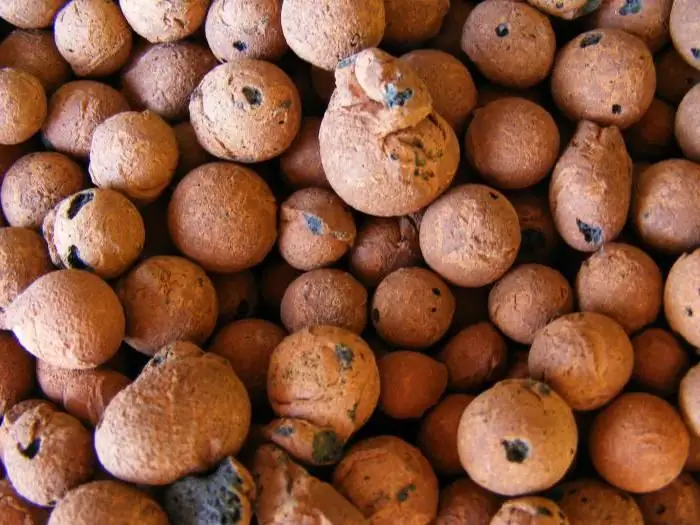2026 Author: Howard Calhoun | [email protected]. Last modified: 2025-01-24 13:10:37
Expanded clay is an environmentally friendly material used for thermal insulation. It is a porous granules that are obtained in the process of firing clay. The process of creating material involves several stages.
On the first of them, the clay swells, which is achieved due to a sharp thermal shock. As a result, it is possible to obtain porous granules. The outer surface of the products is melted, so they are stable and durable, and also acquire the ability to withstand various kinds of influences. It is no coincidence that the described material has gained such popularity today, because among its advantages is a high ability to retain heat.
Description

Expanded clay fractions can be different, this parameter depends on the technology. It also depends on the manufacturing process whether the material will correspond to the declared quality characteristics. Key features include:
- frost resistance;
- high strength;
- moisture resistance;
- durability;
- best value for money.
Expanded clay is also acquired for the reasonthat it has excellent sound and heat insulation qualities, is chemically inert, is not afraid of fire and does not rot. When studying this material, it is important to know not only what fractions of expanded clay exist, but also about the disadvantages, which include the tendency of the granules to absorb liquid, as a result of which they gradually dry out. The granules are fragile, the master should not forget about this in the process of backfilling the material. Among other things, expanded clay is best used as a dry backfill.
Basic Features

As you know, residential buildings made of burnt bricks are cozier and warmer than those built of concrete. Clay, which is subjected to heat treatment, acts as a rather poor conductor of heat and cold. Building expanded clay has similar characteristics, this is due to the porous structure. However, many consumers are interested in what is the thermal conductivity of the material. This parameter averages 0.12 W/mK. However, factionalism must also be taken into account. Pellets have other properties that make them so popular.
It is impossible not to note the strength. When compression tests are carried out, they make it clear that expanded clay is destroyed by 13% of the total volume. This makes it possible to create a sealing layer from this material. If we are talking about expanded material, then it can be divided into several varieties, each of which will have a certain density.
If we are talking about the M450 brand, the factionwhich varies from 10 to 20 mm, then the density in this case will be 440 kg/m3. If you have the M500 brand in front of you, then its density is 465 kg/m3. Expanded clay fractions are not the only parameter that you should familiarize yourself with. It is also important to know about the specific gravity, the ideal value is within 0.95 g/cm3. While the bulk density will depend immediately on a number of factors, grain size should be included here. Thus, with an expanded clay fraction of 30 mm, one cubic meter of material will weigh 340 kg.
Use of expanded clay

At first glance, it may seem that the scope of expanded clay is not so extensive, but it is not. Granules are able to retain heat well, so a house with such insulation will be cozy. The properties of the material allow it to be used for thermal insulation of ceilings, floors and for attic insulation. Expanded clay is also used as an underlying layer. Granules can be used as a base when creating a concrete screed.
The material is also used when backfilling the foundation. Thanks to the use of expanded clay, it is possible to reduce the depth of laying the foundation of the house by 2 times, this saves material and eliminates freezing of the ground near the foundation. Expanded clay is also used in the construction of baths, laying pipes, as well as in the improvement of garden paths. It is also used to create a drainage system, which allows for higher yields.
Faction

The above material is produced according to state standards that regulate fractions. This parameter can vary from 5 to 10; from 10 to 20 and from 20 to 40 mm. After reviewing the documentation, you will be able to understand that expanded clay filler is divided into 10 grades that differ in density, this parameter can vary from 250 to 800.
Main types: expanded clay gravel

Expanded clay, a fraction, the price of which will be of interest to the consumer, is presented for sale in the form of expanded clay gravel. Its cost per cubic meter is 1350 rubles. This material has the appearance of pellets with a porous surface, which are melted under the influence of high temperature.
These products have an oval shape, and the surface is painted in a dark brown color. Black color is visible on the break. This fine fraction expanded clay has sizes ranging from 5 mm. The maximum figure reaches 40 mm. Among the main features, one should highlight moisture resistance, as well as the absence of substances contraindicated in cement, and fire resistance.
Expanded gravel

This material is obtained by crushing pieces of expanded clay foam mass. If we compare with gravel, then this material has an angular shape. The natural properties of clay are used in production, and the transition to the final state occurs under the influence of high temperature.
Expanded sand
The production of expanded clay sand is carried out in one of several ways. The first involves the use of a rotary kiln, the second uses a vertical kiln, while the third involves the use of mechanical technology. To obtain 0.5 m3 of sand, a cubic meter of finished expanded clay should be used. The density of such sand can vary from 500 to 700 kg/m3.
Choice of fraction for laying the floor
Expanded clay for the floor, the fraction of which usually varies from 5 to 10 mm, is the basis of the solution, to which sand, crushed stone and water are added. Expanded clay crushed stone, the fraction of which varies from 10 to 14 mm, is most often used for the preparation of concrete. If you wondered what fraction of expanded clay for the floor should be used, then you should also pay attention to expanded clay gravel, which is used for laying light and durable floors and can have a size of 5 to 40 mm. However, when mixing, it is necessary to use a fraction in the range from 5 to 10, or from 10 to 20, or from 20 to 40 mm. When there is a need to equip a thin screed, then expanded clay sand should be used, the fraction of which does not exceed 5 mm. Fractions of expanded clay for screed are also selected depending on the room in which you plan to carry out work, as well as what technology will be used.
Conclusion
Today in different regions of Russia expanded clay concrete acts as the basis for mass construction. The most effective is its usefor the manufacture of blocks of grades from M300 to M500. If we talk about the tensile strength, then for these products this indicator varies in the range from 5 to 7.5 MPa.
Recommended:
Porter's strategies: basic strategies, basic principles, features

Michael Porter is a renowned economist, consultant, researcher, teacher, lecturer and author of numerous books. who developed their own competition strategies. They take into account the size of the market and features of competitive advantages. These strategies are detailed in the article
What is crushed dolomite. Its fractions and uses

Crushed dolomitic stone is a versatile building material used in various fields of human activity. Most often used in construction and landscaping
Montmorillonite clay: mineral composition, properties, extraction and applications

Montmorillonite clay is actually a mineral that is very plastic, hence its name. The breed was first mined in France. Currently, a large number of deposits have been developed around the world. Montmorillonite has excellent adsorbing properties. It easily absorbs water and various components, increasing in size up to 20 times. Currently, the mineral is used in many industries
Expanded rabbit breeding is the key to successful rabbit farm development

A rabbit farm at the stage of expansion and development necessarily solves the problems of creating new places for keeping animals. An important issue is the reproduction of rabbits. It is this indicator that contributes to the increase in their livestock and allows you to count on receiving stable income from the sale of products
Expanded clay: thermal conductivity, properties and technical characteristics

Expanded clay is made from slate and clay and is suitable for environmentally friendly and modern housing construction. Expanded clay is also used for decorative purposes, and at home it is suitable for solving the problems of growing cultivated plants

